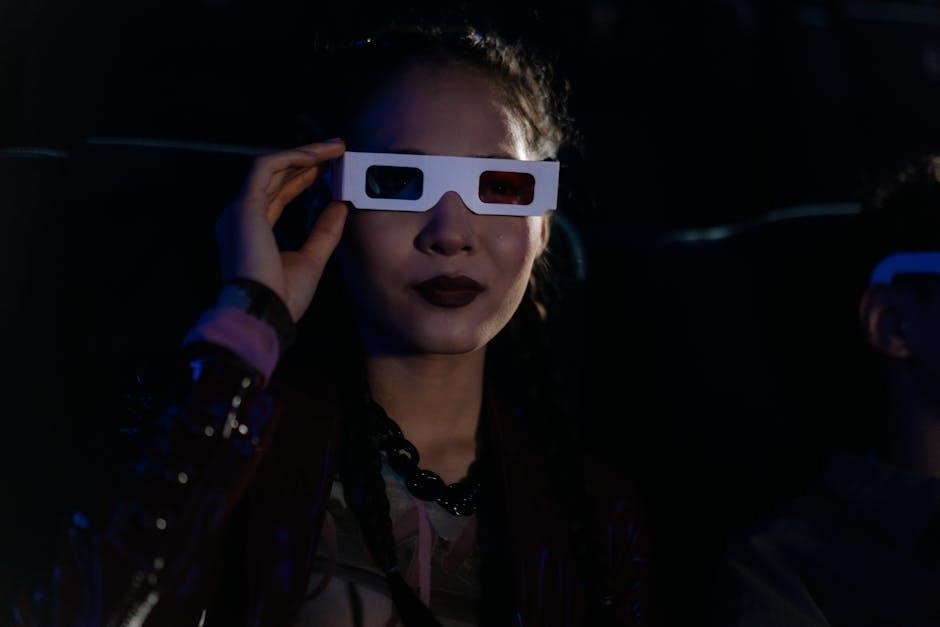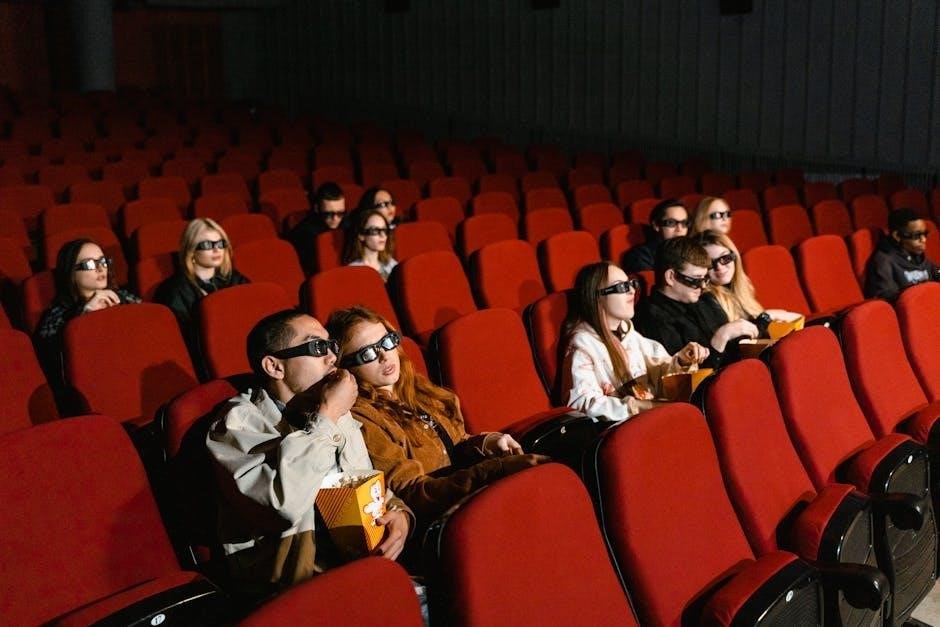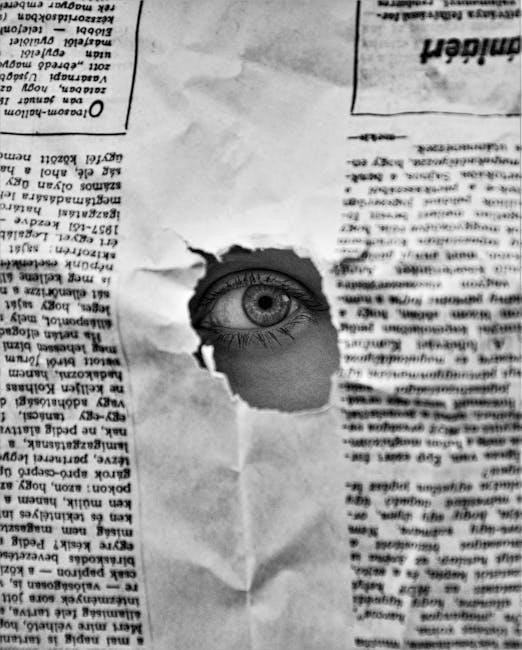
Hidden Figures reveals the untold stories of Black women mathematicians at NASA, showcasing their pivotal roles in the Space Race amid racism and gender barriers.
Overview of the Book and Movie
Hidden Figures, by Margot Lee Shetterly, tells the true story of Black women mathematicians at NASA, focusing on Dorothy Vaughan, Katherine Johnson, and Mary Jackson. The book highlights their contributions to the Space Race despite facing racism and sexism. The movie adaptation, directed by Theodore Melfi, brings these stories to life, emphasizing their resilience and brilliance. Both the book and film explore themes of determination, equality, and overcoming systemic barriers. While the book delves deeper into historical context, the movie captures the emotional and inspirational journey of these women. Together, they shed light on the untold heroism of Black women in STEM, inspiring future generations to pursue careers in science and technology.
Historical Context of the Story
Hidden Figures is set during the 1930s to 1960s, a time of racial segregation and gender discrimination in the United States. The story unfolds against the backdrop of the Civil Rights Movement and the Cold War, where the nation was deeply invested in the Space Race. Black women like Dorothy Vaughan, Katherine Johnson, and Mary Jackson worked as “human computers” at NACA (later NASA), performing critical mathematical calculations for space missions. Despite their expertise, they faced Jim Crow laws, segregated facilities, and limited career advancement. The historical context highlights the societal barriers these women overcame while contributing to landmark achievements like Project Mercury and the Apollo missions. Their work was often unacknowledged, but their resilience and talent played a pivotal role in shaping American history.
Significance of the Title “Hidden Figures”
The title “Hidden Figures” symbolizes the unseen contributions of African-American women mathematicians at NASA during the Space Race. It highlights their crucial roles in pivotal space missions, despite being overlooked due to racial and gender biases. The term “hidden” reflects their marginalization in a society that undervalued their skills, while “figures” underscores their importance in mathematical calculations essential to NASA’s success. The title emphasizes their dual invisibility—both as individuals and as contributors to historic achievements. By shedding light on their stories, the title serves as a metaphor for revealing the hidden truths of their impactful yet unacknowledged work, symbolizing the broader struggle for recognition faced by women of color in STEM fields.
Hidden Figures by Margot Lee Shetterly chronicles the lives of Black women mathematicians at NASA, highlighting their crucial roles in the Space Race despite facing racism and sexism.
Background of the Author, Margot Lee Shetterly
Margot Lee Shetterly, a Virginian native, grew up in Hampton, Virginia, where she was acquainted with several of the women featured in Hidden Figures. Her proximity to their stories inspired her to shed light on their contributions. An accomplished writer and researcher, Shetterly is also a recipient of the Alfred P. Sloan Foundation Fellowship. She has a deep interest in the intersection of race, gender, and technology, which is reflected in her work. Her book serves as a testament to the overlooked achievements of Black women in STEM during the mid-20th century, offering a fresh perspective on NASA’s history and the Space Race.
Main Characters: Dorothy Vaughan, Katherine Johnson, and Mary Jackson
Dorothy Vaughan, Katherine Johnson, and Mary Jackson were trailblazing Black women whose contributions at NASA reshaped the Space Race. Dorothy Vaughan, a mathematician and supervisor, led the West Area Computing Unit, advocating for her team’s recognition and career advancement. Katherine Johnson, renowned for her precise calculations, played a pivotal role in historic missions like Apollo 11. Mary Jackson, an engineer, broke barriers as NASA’s first Black female engineer. Together, they defied racial and gender barriers, proving their indispensable value to the space program. Their stories, marked by resilience and brilliance, highlight their transformative impact on STEM and American history.
Key Events and Achievements in the Book
The book highlights pivotal moments in the lives of Dorothy Vaughan, Katherine Johnson, and Mary Jackson. Dorothy Vaughan’s leadership in the West Area Computing Unit and her eventual promotion to supervisor marked a significant achievement. Katherine Johnson’s precise calculations for the Apollo 11 mission demonstrated her critical role in NASA’s success. Mary Jackson’s determination to become an engineer, despite systemic barriers, showcased her resilience. Key events include their contributions to the launch of Alan Shepard, the first American in space, and the Friendship 7 mission. These achievements underscore their indispensable roles in the Space Race, challenging racial and gender norms while advancing NASA’s historic milestones.

Movie Adaptation
Directed by Theodore Melfi, the film stars Taraji P. Henson, Octavia Spencer, and Janelle Monáe, portraying the struggles and triumphs of the women who defied racial and gender barriers at NASA.
Differences Between the Book and the Movie
The book provides a deeper, detailed account of the lives of Dorothy Vaughan, Katherine Johnson, and Mary Jackson, while the movie simplifies and condenses their stories for cinematic appeal. The film focuses on key events like Katherine’s role in the Apollo 11 mission and the dismantling of racial segregation in NASA’s facilities, whereas the book explores broader historical context and personal struggles. Some characters, like Katherine’s husbands, are less prominent in the movie. The film also adds dramatic scenes, such as Katherine’s car breaking down, which are not in the book. Overall, the movie captures the essence of their achievements but omits some nuances and secondary characters detailed in the book.
Major Themes Portrayed in the Film
The film Hidden Figures explores themes of racism, gender discrimination, and the struggle for equality during the Civil Rights era. It highlights the resilience and determination of Black women in STEM fields, challenging societal norms and breaking barriers. The power of education and intellect is emphasized, showing how these women overcame obstacles to achieve greatness. Teamwork and camaraderie among the characters underscore the importance of collaboration in overcoming adversity. The film also portrays the societal shifts of the 1960s, including the Civil Rights Movement and the Space Race, contextualizing the women’s contributions. Ultimately, it celebrates their triumphs and inspires future generations to pursue careers in STEM, emphasizing diversity and inclusion. These themes are central to the film’s message of empowerment and social change.
Impact of the Movie on Popular Culture
Hidden Figures had a profound impact on popular culture, inspiring widespread recognition of the contributions of Black women in STEM. The film’s success sparked conversations about race, gender, and representation, resonating globally. It became a cultural phenomenon, earning critical acclaim and commercial success, including an Oscar nomination. The movie brought attention to the real-life stories of Katherine Johnson, Dorothy Vaughan, and Mary Jackson, amplifying their legacies. It influenced educational initiatives, encouraging diversity in STEM fields and inspiring young girls to pursue careers in math and science. The film also spurred societal change, with NASA naming a building after Katherine Johnson in 2019. Its cultural significance lies in its ability to challenge stereotypes and celebrate unsung heroes, leaving a lasting legacy in media representation and social justice movements. The movie continues to inspire future generations, emphasizing the power of perseverance and equality.

Study Guide and Analysis
The study guide provides summaries, analysis, and themes, offering insights into the characters’ struggles and triumphs, while addressing gender bias and social justice through educational tools.

Themes in Hidden Figures
The central themes of Hidden Figures include perseverance, racism, gender discrimination, and female empowerment. The film highlights the struggles of Black women in a male-dominated, racially segregated workplace, emphasizing their resilience and determination. It explores the intersection of racism and sexism, showcasing how these women overcame societal barriers to achieve greatness. The theme of identity is also prominent, as the characters navigate their roles as professionals, mothers, and community members. The film underscores the importance of education and STEM careers, inspiring future generations. Historical context, such as the Space Race and the Civil Rights Movement, further enriches the narrative, illustrating the broader societal challenges these women faced. Ultimately, the story celebrates their contributions to NASA’s success and their lasting impact on diversity and inclusion.
Symbolism and Literary Devices
In Hidden Figures, symbolism and literary devices underscore the themes of resilience and equality. The “glass ceiling” metaphorically represents the barriers faced by Black women, while their eventual breakthrough symbolizes triumph. The contrast between closed doors and open opportunities highlights systemic segregation and the women’s determination to overcome it. Mathematics serves as a universal language, bridging racial divides and showcasing their intellectual contributions. Flashbacks and voiceovers provide emotional depth, emphasizing the personal sacrifices and struggles of the characters. These devices collectively amplify the narrative’s emotional impact, illustrating the women’s journey from obscurity to recognition. The film’s use of light and shadow symbolizes their emergence from the shadows of history, emphasizing their pivotal roles in NASA’s success.
Character Analysis: Strengths and Struggles
Dorothy Vaughan, Katherine Johnson, and Mary Jackson exemplify resilience and determination. Dorothy’s leadership and strategic thinking helped her team thrive, while Katherine’s mathematical brilliance and quiet confidence earned her respect. Mary’s ambition and advocacy for equality drove her to pursue engineering. Each faced racism and sexism, yet their strength lay in perseverance. Their struggles included segregated facilities, limited opportunities, and societal biases, but their collective impact transformed NASA. Their journeys highlight personal and professional sacrifices, proving their value in a male-dominated field. Through their stories, the film showcases how their unique strengths overcame systemic barriers, leaving a lasting legacy in STEM and civil rights history.

Discussion Questions
How did the characters overcome racial and gender barriers?
What were the key contributions of each woman to NASA’s success?
How did societal norms impact their personal and professional lives?
What message does the film convey about diversity and inclusion?
How can their experiences inspire future generations in STEM fields?
Questions About Racism and Gender Discrimination
How did the film portray the systemic racism faced by Black women at NASA?
What specific acts of discrimination did Katherine, Dorothy, and Mary encounter?
How did gender bias further complicate their experiences as Black women in STEM?
In what ways did the characters challenge or subvert racist and sexist norms?
How did societal attitudes toward race and gender evolve over the course of the film?
What role did segregation play in their daily lives and work environments?
How did the women support each other in the face of discrimination?
What message does the film convey about the intersection of racism and sexism?
How did the characters’ resilience and determination impact their ability to succeed?
What lessons can be learned from their experiences regarding equality and inclusion?
Questions on STEM and Career Contributions
What were the primary roles of Dorothy Vaughan, Katherine Johnson, and Mary Jackson at NASA?
How did their mathematical skills contribute to NASA’s success during the Space Race?
What challenges did they face in pursuing careers in STEM fields?
How did Katherine Johnson’s calculations impact the Apollo 11 mission?
What steps did Mary Jackson take to become an engineer, and why was this significant?
How did Dorothy Vaughan’s leadership in the West Computing Group advance the team’s work?
What barriers did the women face in gaining recognition for their contributions?
How did their work influence the development of the space program?
What legacy did they leave for future generations in STEM?
How did their careers challenge stereotypes about women in science and technology?
Reflection on Social Justice and Diversity
Hidden Figures highlights the struggle for social justice and diversity during the Civil Rights era, showcasing how Black women like Katherine Johnson, Mary Jackson, and Dorothy Vaughan overcame systemic racism and gender discrimination. Their experiences reflect the broader societal norms of segregation and inequality, while their achievements demonstrate the power of resilience and determination. The film and book emphasize the importance of inclusivity and equal opportunities in the workplace, illustrating how their contributions were vital to NASA’s success. These women’s stories inspire conversations about representation, equity, and the dismantling of stereotypes. Their legacy challenges modern audiences to continue advocating for diversity and inclusion, ensuring that all individuals, regardless of race or gender, can thrive in STEM fields and beyond.

Activity and Lesson Ideas
Engage students with biography research projects, STEM challenges, and discussions on diversity, using Hidden Figures to explore history, science, and social justice.
Classroom Activities for Students

Engage students with interactive lessons inspired by Hidden Figures. Assign biography research projects on Katherine Johnson, Dorothy Vaughan, and Mary Jackson, focusing on their contributions to NASA. Incorporate STEM challenges, such as calculating trajectories or designing spacecraft, to connect math and science to real-world applications. Conduct group discussions on themes like racism, gender discrimination, and perseverance. Encourage reflective essays on how the women’s stories inspire personal goals. Use film clips to spark debates on historical context and social justice. These activities promote critical thinking, collaboration, and a deeper understanding of the intersection of history, STEM, and diversity.
Biography Research Projects
Assign students to research the lives of Katherine Johnson, Dorothy Vaughan, and Mary Jackson, exploring their early lives, education, and contributions to NASA. Provide guided questions to focus their research, such as their challenges, achievements, and legacies. Encourage the use of credible sources, including the book, film, and NASA archives. Students can create detailed biographies, timelines, or presentations highlighting their discoveries. Extend the project by asking students to reflect on how these women’s stories inspire their own academic or career goals. This activity fosters historical understanding, critical thinking, and appreciation for the women’s pivotal roles in STEM history. It also promotes research and presentation skills, aligning with educational standards.
Interdisciplinary Connections (STEM, History)
Hidden Figures bridges STEM and history, offering a rich opportunity to explore the intersection of mathematics, engineering, and the social dynamics of the 1960s; The film and book highlight the critical role of Black women in NASA’s success during the Space Race, emphasizing their mathematical expertise and problem-solving skills. By examining their contributions, students can gain insights into the historical context of the Civil Rights Movement and the barriers these women overcame. Activities can include analyzing primary sources, such as NASA’s archival documents, or discussing how societal norms influenced their careers. This connection fosters a deeper understanding of STEM’s real-world applications and the importance of diversity in innovation. It also aligns with educational standards in history, math, and science.

Historical Context
Hidden Figures is set during the 1930s-1960s, highlighting Black women’s roles at NASA amid the Space Race and Civil Rights Movement, revealing their unseen contributions to history.
The Role of Black Women in NASA’s History
Black women played a pivotal role at NASA, serving as human computers who performed critical mathematical calculations for space missions. They faced both racial and gender discrimination but persevered, contributing significantly to the success of the Space Race. Their work was essential in launching astronauts like Alan Shepard and John Glenn into space. Despite their achievements, their contributions were often overlooked until recent years. The film and book Hidden Figures shed light on their stories, highlighting the challenges they overcame and their lasting impact on NASA’s history. Their legacy serves as an inspiration, showing how determination and talent can overcome adversity and shape the course of history.
The Space Race and Its Significance
The Space Race was a pivotal Cold War competition between the U.S. and the Soviet Union, driven by technological and ideological rivalry. It began with the Soviets’ launch of Sputnik in 1957 and culminated in the U.S. landing astronauts on the Moon in 1969. This era marked a turning point in human history, showcasing scientific advancement and national pride. The success of NASA’s missions, such as Project Mercury and Apollo 11, relied heavily on precise calculations, where Black women mathematicians played a crucial role. Their contributions were essential to achieving these milestones, demonstrating how diversity and inclusion fueled American progress. The Space Race not only advanced space exploration but also inspired future generations to pursue STEM careers, leaving a lasting legacy in history.
Civil Rights Movement and Its Impact
The Civil Rights Movement was a transformative era in the 1950s and 1960s, fighting against racial segregation and discrimination in America. It sought equality and justice for African Americans through peaceful protests, legal challenges, and grassroots activism. The movement’s impact is evident in “Hidden Figures,” as it highlights the struggles of Black women like Katherine Johnson, Dorothy Vaughan, and Mary Jackson, who faced both racial and gender barriers. Their stories reflect the broader societal changes, as they challenged segregation in the workplace and beyond. The movement’s success led to gradual desegregation and more opportunities for African Americans, inspiring future generations to pursue careers in STEM and break societal norms, leaving a lasting legacy of resilience and progress.

Impact and Legacy
Hidden Figures inspired future generations, especially women and minorities, to pursue STEM careers, while shedding light on the unrecognized contributions of Black women in NASA’s history.
How Hidden Figures Inspired Future Generations
Hidden Figures has become a beacon of inspiration, particularly for women and minorities, showcasing the power of perseverance and talent in overcoming systemic barriers. By highlighting the achievements of Dorothy Vaughan, Katherine Johnson, and Mary Jackson, the book and film have sparked a renewed interest in STEM careers among young people. The stories of these trailblazers challenge stereotypes and emphasize the importance of diversity in innovation. Many students, especially girls of color, have found role models in these women, inspiring them to pursue mathematics, engineering, and science. The film’s success has also led to educational initiatives and scholarships, further cementing the legacy of these hidden figures. Their journeys remind us that breaking societal norms and striving for excellence can create lasting change.
Recognition of the Women’s Contributions
The women featured in Hidden Figures have finally received the recognition they deserve, decades after their contributions to NASA’s success. The book and film brought their stories to the forefront, highlighting their critical roles in the Space Race. Dorothy Vaughan, Katherine Johnson, and Mary Jackson were pioneers who broke racial and gender barriers, proving their invaluable worth as mathematicians and engineers. Their work was instrumental in the success of historic missions, such as the Apollo 11 landing. Today, their achievements are celebrated through numerous awards, including the Presidential Medal of Freedom for Katherine Johnson. This overdue acknowledgment not only honors their legacy but also serves as a powerful reminder of the importance of diversity and inclusion in shaping history. Their contributions continue to inspire future generations.
Cultural and Educational Influence
Hidden Figures has left a profound cultural and educational impact, inspiring countless individuals, especially women and minorities, to pursue STEM careers. The book and film have sparked conversations about diversity, inclusion, and the importance of recognizing overlooked contributions. Educational resources, such as study guides and curriculum materials, have been developed to integrate the story into classrooms, aligning with subjects like history, math, and science. The film’s success has also led to initiatives promoting STEM education for underrepresented groups. By shedding light on these trailblazers, Hidden Figures has fostered a cultural shift, encouraging a more equitable representation of women and minorities in STEM fields. Its legacy continues to empower future generations to break barriers and pursue their aspirations.

Answer Key and Resources
Hidden Figures provides key answers to study guide questions, recommended readings, and additional resources for further exploration of the women’s contributions and legacy.
Key Answers to Study Guide Questions
The study guide for Hidden Figures provides detailed answers to essential questions, such as the identities of the main characters, the meaning of the title, and the historical context. Key points include:
- Dorothy Vaughan, Katherine Johnson, and Mary Jackson were the central figures who broke racial and gender barriers at NASA.
- The term “hidden figures” refers to the Black women mathematicians whose contributions were often overlooked until the book and film.
- Their work was crucial in NASA’s success during the Space Race, including the Apollo 11 mission.
Additional answers explore themes like racism, perseverance, and the intersection of STEM and social justice, offering a comprehensive understanding of the story’s significance.
Recommended Reading and Viewing
For a deeper understanding of Hidden Figures, explore Margot Lee Shetterly’s book, which provides a detailed account of the lives of Dorothy Vaughan, Katherine Johnson, and Mary Jackson. The film adaptation, directed by Theodore Melfi, offers a visual narrative of their journeys and struggles. Additionally, documentaries like The Real Hidden Figures and NASA’s Human Computers provide further insights into their contributions. For educational purposes, study guides from SparkNotes, LitCharts, and Quizlet are excellent resources. Related books such as Rise of the Rocket Girls and We Could Not Fail expand on the broader context of women in STEM. These resources collectively offer a comprehensive view of the historical and cultural significance of the story.
Additional Resources for Further Study
For further exploration of Hidden Figures, consider the following resources:
- NASA’s Hidden Figures Website: Offers detailed profiles of Katherine Johnson, Dorothy Vaughan, and Mary Jackson, along with archival documents and photos.
- SparkNotes and LitCharts Study Guides: Provide in-depth analyses of themes, characters, and literary devices in the book and film.
- PBS Documentaries: Features documentaries on the history of NASA and the role of Black women in STEM during the Space Race.
- Quizlet Flashcards: Helps students memorize key terms and events related to the story.
- Teacher’s Guides: Includes lesson plans and discussion questions for integrating Hidden Figures into classroom curricula.
These resources enrich understanding and provide interactive ways to engage with the story’s themes and historical context.